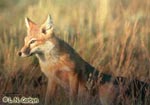|

Small populations of the Swift Fox have been re-established in southern Alberta and Saskatchewan. Status: endangered. Click to enlarge.
|
Several hundred wild plant and animal species are currently at risk of disappearing in Canada. Some species are already extirpated, meaning that they are no longer found in Canada. The Species at Risk Act (SARA), the federal law that protects these wild species, was assented in December 2002 and took full effect June 1, 2004.
Many different wildlife species are now fully protected, including birds, fish, mammals, amphibians, reptiles, insects and plants. The current list of protected species is contained in SARA Schedule 1.
|
SARA Key Aspects
It is important to understand the key protection aspects and the circumstances in which the Act applies in order to determine if you have obligations to fulfill under the Act and to comply with SARA requirements.
Prohibitions as of June 1, 2004
SARA makes it an offence to kill, harm, harass, capture, take, possess, collect and sell species at risk protected by the Act. It is also an offence to possess, collect, trade and sell parts or products derived from protected species.
Under the Act, it is illegal to destroy or damage the residence, for example the nest or den, of a protected species. The critical habitat of the species, necessary for their survival and recovery, can also be protected. In this way, SARA protects the space wild species need to live, find food, reproduce and raise their young.
The prohibitions of the Species at Risk Act apply to all species listed in SARA Schedule 1 as endangered, threatened or extirpated species. For aquatic species and birds listed in the Migratory Birds Convention Act, 1994, the prohibitions apply everywhere in Canada. These prohibitions also apply to all other species listed in SARA Schedule 1 found on federal land.
Other species at risk in Canada are primarily protected by provincial or territorial laws. However, if these species are not effectively protected, SARA has provisions that act as a safety net authorizing the Canadian government to protect them.
Moreover, the Act stipulates that other species may be added to the list of species protected by the Act. Species are assessed by, the Committee on the Status of Endangered Wildlife in Canada (COSEWIC), an independent scientific committee, which is established under SARA by law. COSEWIC assesses and classifies wildlife species using the best available scientific, community and aboriginal traditional knowledge.
Permitted Activity and Exceptions
Under certain conditions, agreements and permits could authorize individuals to carry out activities that would otherwise violate SARA. For example, a scientist may be allowed to handle and tag an endangered species so that its movements can be tracked. Or, water flow could be diverted in a marsh to improve habitat for listed species in the area, although this might disturb some individuals of the species in the short term.
|
|





